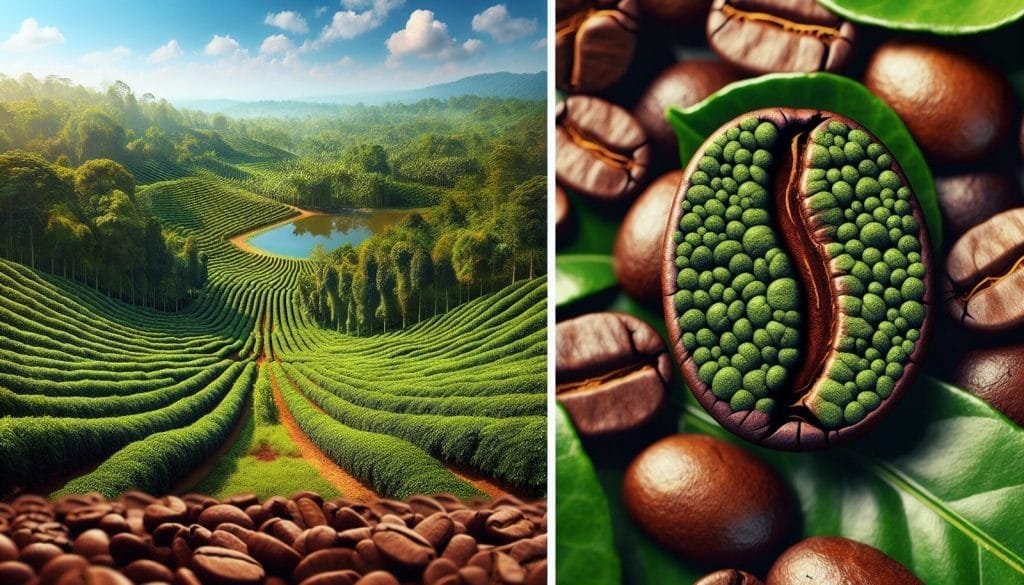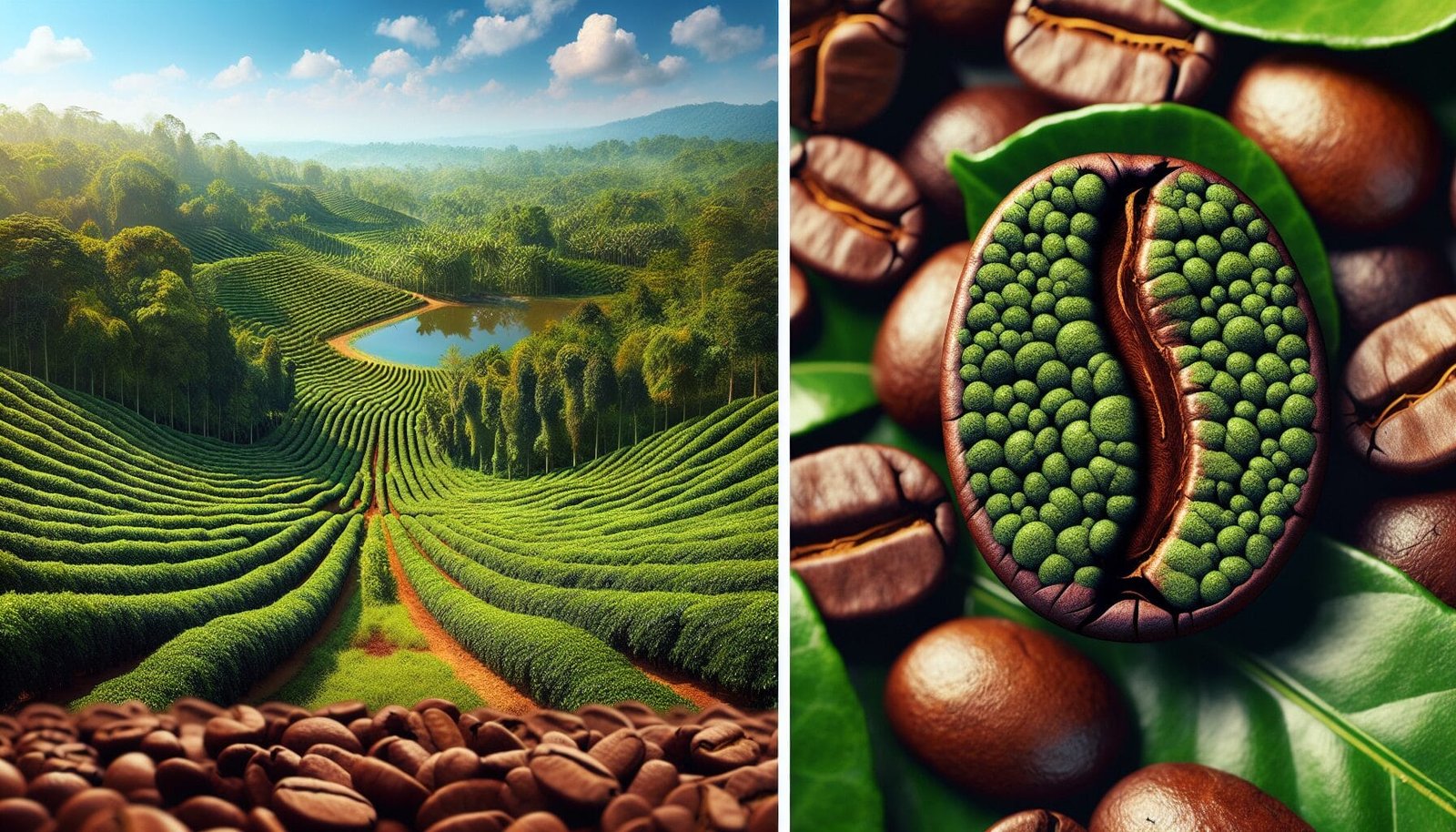Close your eyes and imagine the rich aroma of freshly brewed coffee wafting through the air, instantly awakening your senses. But have you ever wondered, amidst the countless varieties of coffee beans, which one is used in most of the coffees we savor? As you explore the world of coffee, its countless flavors, and the mesmerizing stories behind each cup, you will soon discover the true star of the show – a bean that has captured the hearts of caffeine enthusiasts worldwide.

Types of coffee beans
When it comes to coffee, there are various types of beans that are used to create the perfect brew. Two of the most popular and widely-used beans are Arabica and Robusta. Each of these beans offers a unique flavor profile, caffeine content, growing conditions, and cost, making them distinct from one another. Let’s dive into the details and explore the differences between Arabica and Robusta beans, as well as delve into other coffee bean varieties.
Differences between Arabica and Robusta beans
Flavor profile
One of the major differences between Arabica and Robusta beans lies in their flavor profiles. Arabica beans are renowned for their delicate and complex flavors. They often possess a wide range of flavors, including fruity, floral, and even chocolatey undertones. On the other hand, Robusta beans tend to have a stronger and more bitter taste, with hints of earthiness and nuttiness. The flavor profile of each bean is a crucial factor to consider when selecting your preferred coffee bean.
Caffeine content
Caffeine content is another differentiating factor between Arabica and Robusta beans. Arabica beans have lower caffeine content compared to Robusta beans. On average, Arabica contains about 1.2% caffeine, while Robusta can contain up to 2.7% caffeine. This disparity in caffeine levels is substantial and can greatly impact the overall experience of consuming coffee. If you prefer a milder caffeine buzz, Arabica beans might be the better choice for you.
Growing conditions
Arabica and Robusta beans thrive in different growing conditions. Arabica beans are generally grown at higher altitudes, typically between 600 to 2,200 meters above sea level. They require a cooler climate, rich soil, and ample rainfall for optimal growth. On the other hand, Robusta beans can tolerate lower altitudes and are often found in regions with higher temperatures and more arid climates. These different growing conditions contribute to the unique characteristics and flavors of each coffee bean.
Cost
The cost of coffee beans also varies between Arabica and Robusta. Arabica beans tend to be more expensive compared to Robusta beans. This is primarily due to several factors, including the higher cost of cultivation, lower yields, and the perceived quality associated with Arabica coffee. The labor-intensive cultivation process and the delicate nature of Arabica plants contribute to their higher price in the market. Robusta beans, being hardier and more resistant to pests and diseases, are generally more affordable for coffee enthusiasts.
Arabica beans
Arabica beans are often considered the gold standard in the world of coffee. Known for their superior quality, Arabica beans showcase a multitude of unique characteristics that set them apart from other coffee beans.
Origin
The origins of Arabica beans can be traced back to the highlands of Ethiopia. This is where coffee cultivation is believed to have originated. Today, Arabica beans are grown across various regions worldwide, including Central and South America, Africa, and Asia. Each region brings its own distinct flavor nuances to the coffee beans.
Characteristics
Arabica beans are known for their exceptional flavor and aroma. They have a smooth, well-rounded taste that is often described as complex and nuanced. The flavors can range from bright and fruity to floral and even chocolatey. Additionally, Arabica beans tend to have lower acidity levels compared to other coffee bean varieties, resulting in a less bitter aftertaste.
Cultivation
The cultivation process of Arabica beans requires specific conditions to ensure optimal growth and flavor development. Arabica plants prefer cooler temperatures, shade, and well-drained soils. They are typically cultivated on mountainsides or in high-altitude regions, where the temperature fluctuations enhance the development of the beans’ flavors.
Processing
After being harvested, Arabica coffee cherries undergo various processing methods to extract the beans. Some common methods include the washed process, natural process, and honey process. Each processing method contributes to the beans’ flavor profile, as they absorb distinct characteristics from their surrounding environment during the drying process.
Popular varietals
Within the Arabica bean category, there are numerous varietals that coffee enthusiasts rave about. Some popular Arabica varietals include Typica, Bourbon, and Geisha. Each varietal brings its own unique taste and flavor profile to the table, showcasing the diversity within the world of Arabica coffee.
Robusta beans
While Arabica beans often steal the spotlight, Robusta beans have their own distinct qualities that make them a valuable addition to the coffee industry.
Origin
Robusta beans originated in sub-Saharan Africa and were later introduced to other parts of the world. Today, they are primarily cultivated in regions such as Vietnam, Brazil, and Indonesia. Robusta plants are known for their resilience and adaptability, making them suitable for various growing conditions.
Characteristics
Robusta beans have a robust flavor profile, as the name suggests. They are characterized by a strong, full-bodied taste with higher acidity levels compared to Arabica beans. Additionally, Robusta beans contain more caffeine, which contributes to their bolder and more intense flavor.
Cultivation
Due to their hardiness, Robusta plants can thrive in lower altitudes and more unfavorable climates. They require less shade and can withstand higher temperatures compared to Arabica plants. This resilience makes Robusta beans a more accessible and cost-effective option for coffee farmers.
Processing
Similar to Arabica beans, Robusta beans undergo various processing methods to prepare them for consumption. These methods include the wet process, dry process, and semi-washed process. The processing method can significantly impact the final flavor of the beans, allowing coffee roasters to manipulate the taste based on their preferences.
Usage in coffee blends
While Robusta beans are often consumed on their own, they are frequently used in coffee blends to enhance the flavor and texture. Due to their higher caffeine content and strong flavor profile, Robusta beans add depth and intensity to blended coffees. They often contribute to the famous crema layer found in espresso shots, making them a crucial element in the world of specialty coffee.

Other coffee bean varieties
Apart from Arabica and Robusta, there are a few lesser-known coffee bean varieties that have their own unique characteristics.
Liberica beans
Liberica beans are a rare and exotic coffee bean variety. They originated in West Africa and are known for their distinct, fruity flavor and woody aroma. Liberica beans are often used as a specialty ingredient in high-quality blends, providing a unique twist to the coffee drinking experience.
Excelsa beans
Excelsa beans, though considered a distinct variety, are actually a sub-species of Liberica. They possess a unique flavor that combines the fruity notes of Liberica with a touch of dark and earthy undertones. Excelsa beans are generally used to add complexity to coffee blends, giving them a multi-dimensional flavor profile.
Flavor considerations in coffee beans
When it comes to selecting the perfect coffee bean, flavor considerations play a crucial role in determining your preference. Here are a few key factors to consider:
Acidity
Acidity in coffee refers to the perceived brightness or liveliness on the palate. Arabica beans generally have a higher acidity level compared to Robusta beans, providing a tangy or citrusy flavor. If you enjoy a brighter and more vibrant coffee experience, Arabica beans might be the way to go.
Body
The body of a coffee refers to its texture and mouthfeel. Arabica beans generally have a lighter body, resulting in a smoother and more delicate drinking experience. Robusta beans, on the other hand, offer a fuller and heavier body, providing a robust and lingering sensation on the palate.
Aroma
The aroma of coffee is an essential element in the overall coffee-drinking experience. Arabica beans are renowned for their aromatic qualities, often giving off floral, fruity, or even chocolatey scents. Robusta beans, while less aromatic, can still possess intense and earthy aromas that add depth to the coffee.
In conclusion, the world of coffee beans is diverse and fascinating. Each type of bean, whether it’s the beloved Arabica or the robust Robusta, offers its own unique characteristics, flavors, and qualities. Understanding the differences and nuances between these beans allows coffee enthusiasts to choose the perfect beans to suit their personal preferences. So go ahead, explore the vast world of coffee beans, and embark on a flavor-filled journey that will awaken your senses and ignite your love for coffee.




